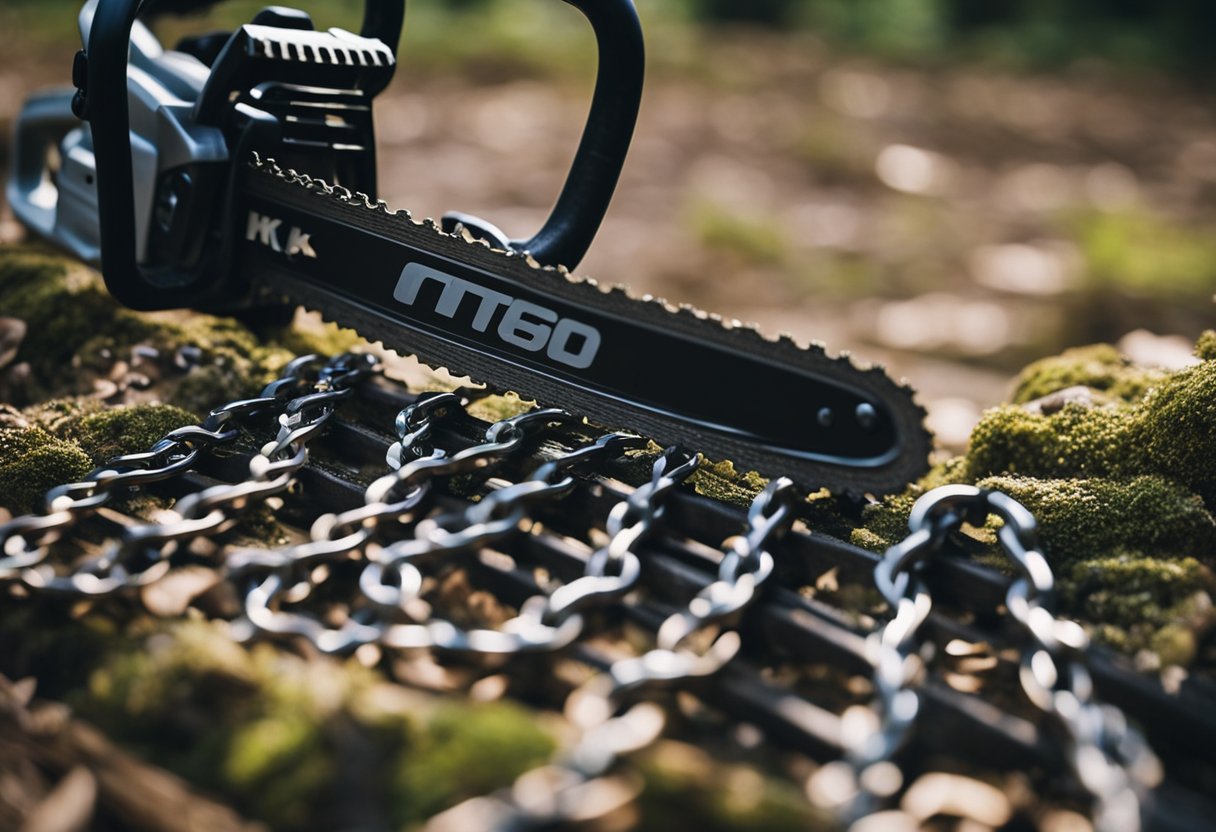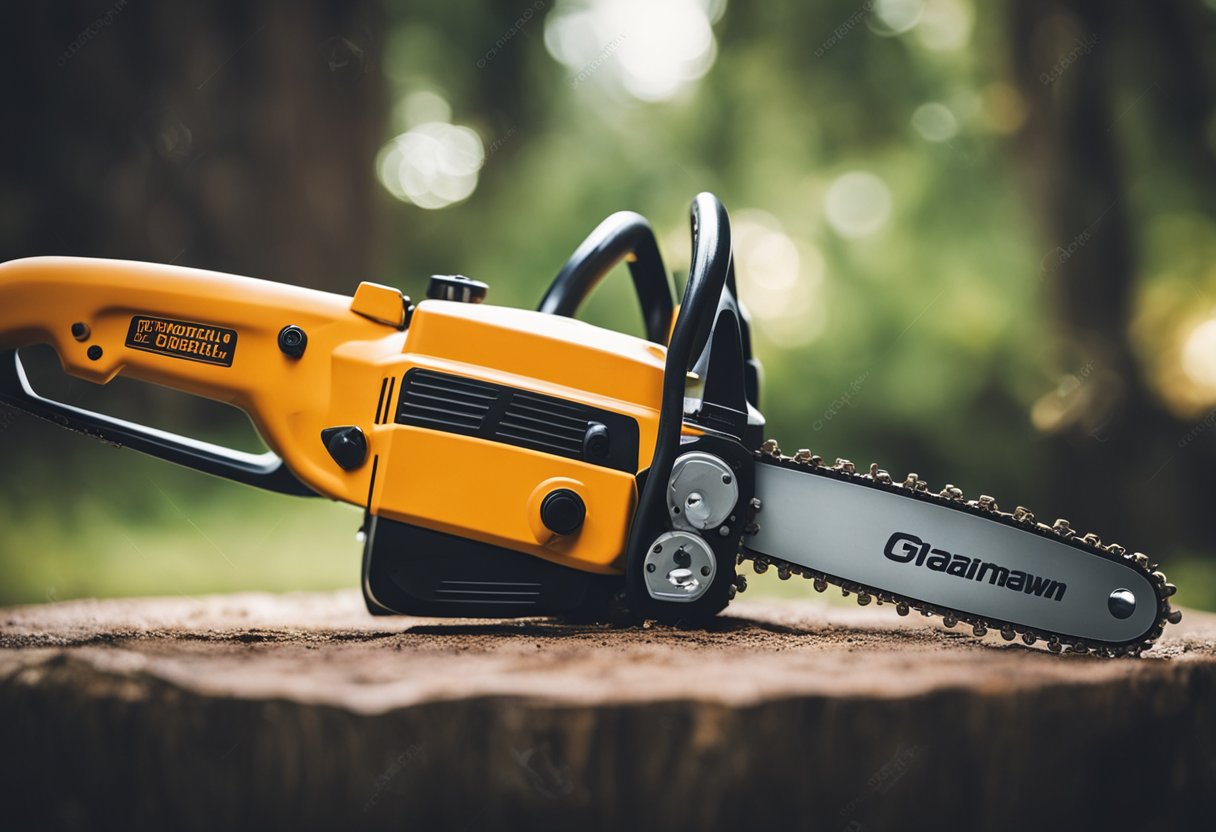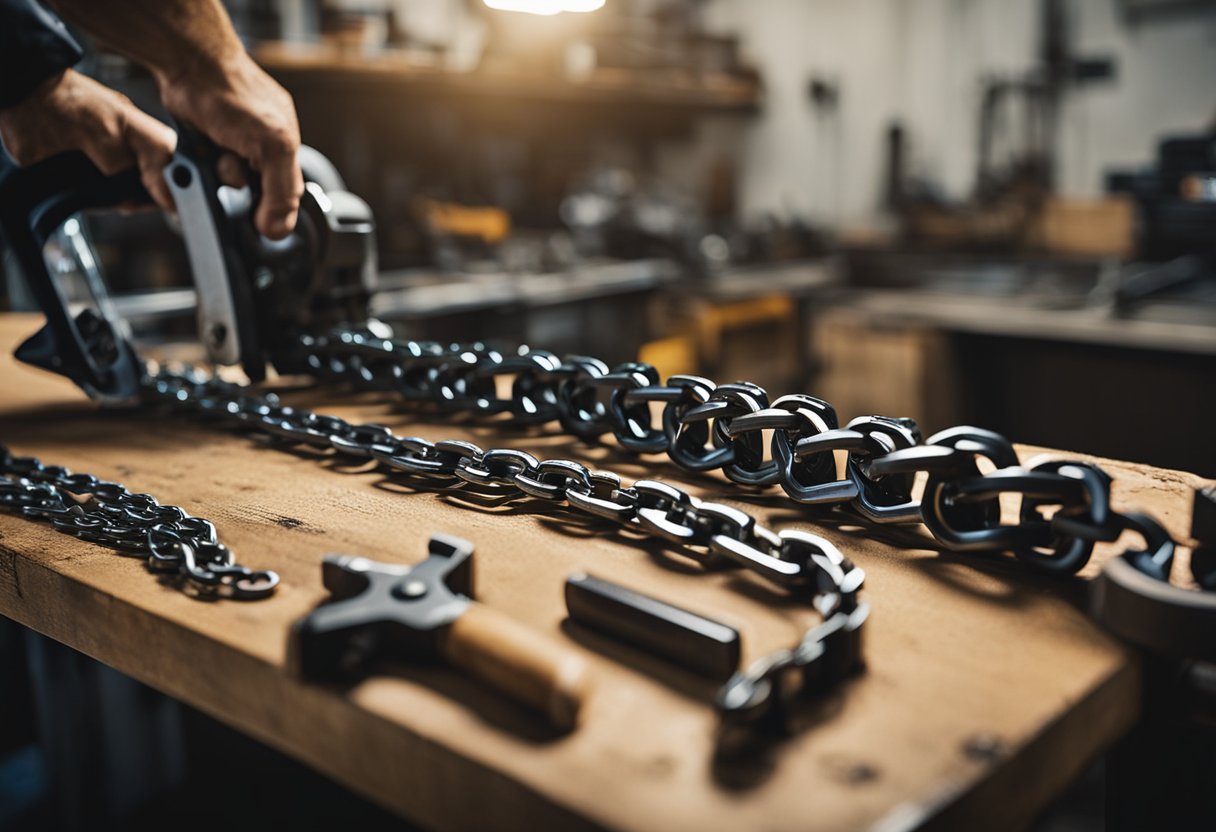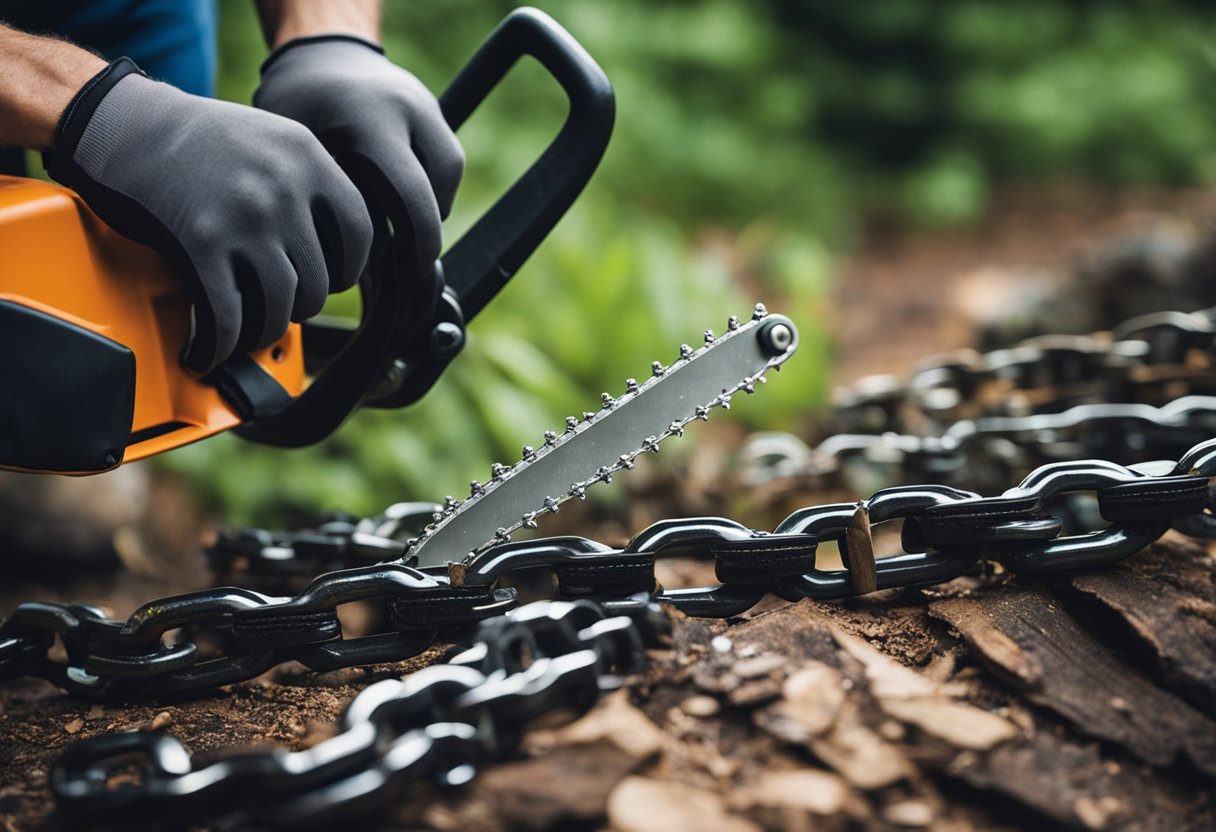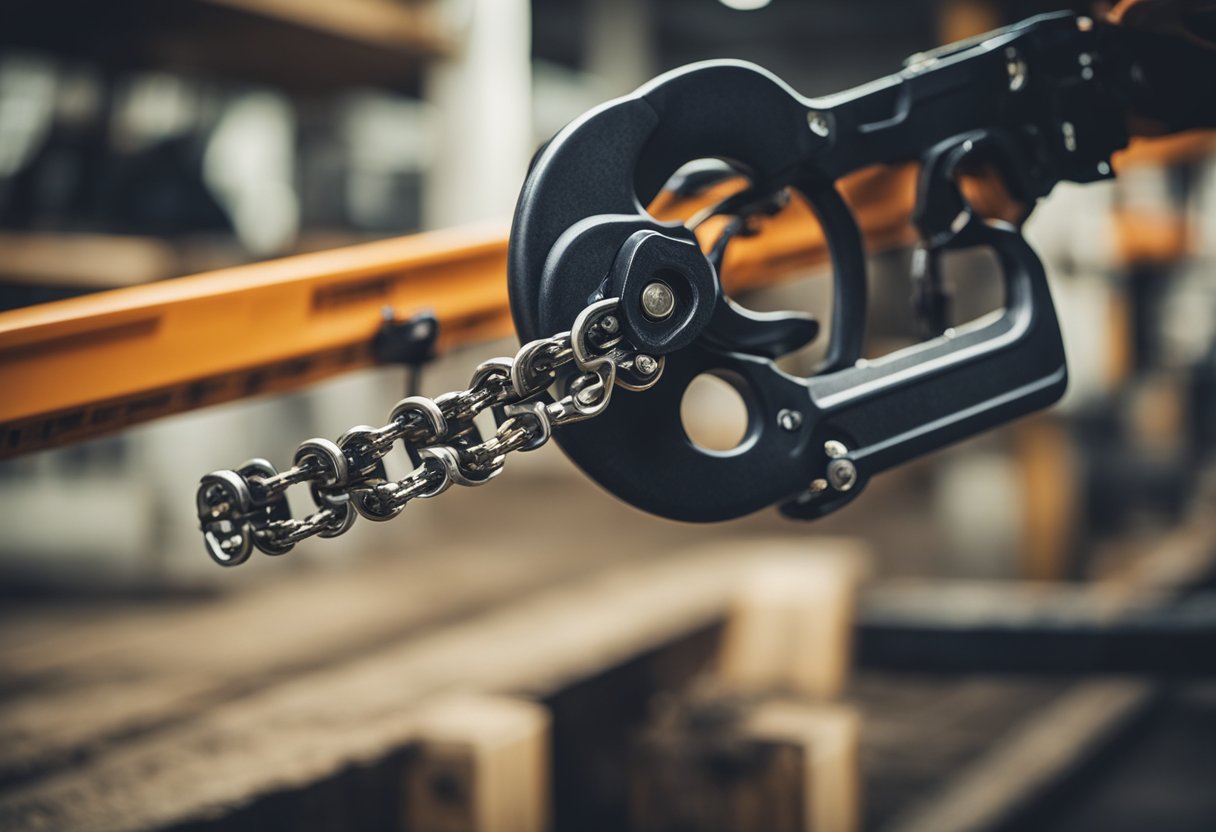I have been using chainsaws for years, and one of the most common questions I get asked is, “Do chainsaw chains stretch?” The answer is yes, chainsaw chains do stretch over time, but it’s not as simple as that. Understanding chainsaw chains, how they work, and why they stretch is crucial for anyone who uses a chainsaw.
The stretching of a chainsaw chain is a natural phenomenon that occurs due to wear and tear from normal use. The chain loop gets longer after repeated use, and as a result, the chain becomes loose and can slip off the bar, which can be very dangerous. So, it’s essential to know how to adjust and maintain chainsaw chain tension to prevent accidents and ensure the chainsaw’s optimal performance.
Key Takeaways
- Chainsaw chains stretch over time due to wear and tear from normal use.
- Proper maintenance, including adjusting chain tension and lubrication, can prevent accidents and ensure the chainsaw’s optimal performance.
- When dealing with chainsaw chains, it’s crucial to follow safety measures to avoid accidents.
Understanding Chainsaw Chains
https://www.youtube.com/watch?v=iY-qgN6StuQ&embed=true
As a chainsaw owner, understanding the chainsaw chain is essential to ensure the right chainsaw is used for the right job. The chainsaw chain is a critical component of the chainsaw that cuts through the wood. Chainsaw chains are designed to be durable and withstand the high stress and pressure generated by the chainsaw.
There are different types of chainsaw chains available in the market, and it is essential to choose the right chainsaw chain for the job. The right chainsaw chain is determined by the type of chainsaw, the length of the chainsaw bar, and the type of wood being cut.
Proper chain maintenance is also critical to ensure the chainsaw chain remains in good working condition. Chainsaw chains need to be sharpened regularly to maintain their cutting edge. A dull chainsaw chain can cause kickback, which can be dangerous to the operator.
Additionally, chainsaw chains stretch over time due to wear and tear. This stretching can cause the chainsaw chain to become loose and affect the chainsaw’s performance. It is essential to monitor the chainsaw chain’s tension regularly and adjust it as necessary to ensure optimal performance.
In summary, understanding the chainsaw chain is essential to ensure the right chainsaw is used for the right job. Proper chain maintenance and monitoring the chainsaw chain’s tension are critical to ensure the chainsaw operates safely and efficiently.
Chain Stretching Phenomenon
https://www.youtube.com/watch?v=XAXjlYu1EFE&embed=true
As an experienced chainsaw user, I have noticed that chainsaw chains can stretch over time. This stretching phenomenon is a result of the metal links rubbing against each other as the chain rotates around the guide bar. The friction between the links causes the chain to expand, resulting in a loose chain that can slip off the bar or cause kickback.
Chain stretching is a normal part of owning and using a chainsaw, and it is not necessarily a bad thing. In fact, some chainsaw manufacturers recommend that you check the tension of the chain after the first few hours of use and then regularly thereafter. This is because a properly tensioned chain will not only reduce the risk of kickback but also increase the lifespan of the chain.
One of the primary causes of chain stretching is thermal expansion as a result of friction. When the chain heats up due to friction, the metal links expand, causing the chain to stretch. This is why it is important to allow the chain to cool down before adjusting the tension.
Another cause of chain stretching is improper tension. If the chain is too loose, it will not only stretch but also increase the risk of kickback. On the other hand, if the chain is too tight, it can cause excessive wear on the chain and the guide bar.
To prevent chain stretching, it is important to properly maintain your chainsaw and regularly check the tension of the chain. You can do this by using a chainsaw file guide or a chainsaw chain tensioner tool. Additionally, using a high-quality chainsaw chain can also reduce the risk of chain stretching.
Overall, chain stretching is a normal part of owning and using a chainsaw. By properly maintaining your chainsaw and regularly checking the tension of the chain, you can reduce the risk of chain stretching and ensure that your chainsaw operates safely and efficiently.
Causes of Chainsaw Chain Stretch
https://www.youtube.com/watch?v=qwoPxS1mCZM&embed=true
As a chainsaw chain is used, it will inevitably stretch over time. There are several factors that can cause chainsaw chains to stretch, including tension, wear and tear, friction, overheating, improper maintenance, and normal wear and tear.
Tension
One of the most common causes of chainsaw chain stretch is improper tension. If the chain is too loose, it will not cut properly, and it will also cause the chain to stretch more quickly. On the other hand, if the chain is too tight, it will put more strain on the chain, causing it to stretch as well. It is important to check the tension of the chainsaw chain regularly and adjust it as needed.
Wear and Tear
Another cause of chainsaw chain stretch is wear and tear. Over time, the chain will become worn down, which can cause it to stretch more easily. This can be caused by a number of factors, including cutting hard materials, using the chainsaw for extended periods of time, and using the chainsaw improperly.
Friction
Friction can also cause chainsaw chains to stretch. When the chain rubs against the guide bar, it can cause the chain to heat up, which can cause it to expand and stretch. This can be exacerbated by using the chainsaw for extended periods of time or by using it improperly.
Overheating
Overheating can also cause chainsaw chains to stretch. When the chain heats up, it can expand and stretch, which can cause it to become loose and ineffective. This can be caused by using the chainsaw for extended periods of time or by using it improperly.
Improper Maintenance
Improper maintenance is another common cause of chainsaw chain stretch. If the chainsaw is not properly maintained, it can cause the chain to become worn down more quickly, which can cause it to stretch more easily. It is important to regularly clean and lubricate the chainsaw and to replace any worn or damaged parts as needed.
Normal Wear and Tear
Finally, normal wear and tear is a natural cause of chainsaw chain stretch. As the chain is used, it will become worn down and will eventually need to be replaced. Regular maintenance and proper use can help to prolong the life of the chainsaw chain, but it will eventually need to be replaced.
Signs of a Stretched Chainsaw Chain
https://www.youtube.com/watch?v=w1Gy8d3xtAc&embed=true
As a chainsaw user, it is essential to know the signs of a stretched chainsaw chain. A stretched chainsaw chain can cause a lot of problems and reduce the performance of your chainsaw. Here are some signs that your chainsaw chain is stretched:
1. Loose Chain
A loose chain is one of the most common signs of a stretched chainsaw chain. When the chain is loose, it will not cut effectively, and it will cause your chainsaw to vibrate excessively. A loose chain can also cause the chain to come off the bar, which can be dangerous.
2. Reduced Cutting Performance
A stretched chainsaw chain will not cut as well as a new chain. It will take longer to cut through wood, and the cuts will not be as clean. If you notice that your chainsaw is not cutting as well as it used to, it could be a sign that your chain is stretched.
3. Excessive Noise
A stretched chainsaw chain will make more noise than a new chain. You will hear a lot of rattling and grinding sounds coming from your chainsaw. This noise is caused by the chain rubbing against the bar and the sprocket.
4. Increased Vibration
A stretched chainsaw chain will cause your chainsaw to vibrate excessively. This vibration can make it difficult to control the chainsaw and can cause fatigue in your hands and arms. If your chainsaw is vibrating more than usual, it could be a sign that your chain is stretched.
5. Worn-out Chain
A stretched chainsaw chain is a sign that your chain is worn out and needs to be replaced. If you continue to use a stretched chain, it will cause more damage to your chainsaw and reduce its lifespan.
In conclusion, knowing the signs of a stretched chainsaw chain is essential for maintaining the performance and safety of your chainsaw. If you notice any of these signs, it is time to replace your chain.
How to Adjust and Maintain Chainsaw Chain Tension
https://www.youtube.com/watch?v=V9RUt22UNEY&embed=true
As a chainsaw owner, it is important to know how to properly adjust and maintain the tension of the chainsaw chain. A loose chain can cause damage to the chainsaw, while an overly tight chain can cause the chainsaw to malfunction and even pose a safety hazard.
To adjust the chainsaw chain tension, start by locating the tension adjustment screw. This screw is typically found on the side panel of the chainsaw and can be adjusted using a flathead screwdriver.
Before adjusting the tension, make sure the chainsaw is turned off and the chain is cool to the touch. Then, use the screwdriver to loosen the bolts on the side panel and remove the panel to expose the tension adjustment screw.
Next, use the screwdriver to turn the tension adjustment screw clockwise to tighten the chain or counterclockwise to loosen the chain. Be sure to make small adjustments and check the tension frequently until the chain is properly tensioned.
Once the chain is properly tensioned, replace the side panel and tighten the bolts. It is important to regularly check and adjust the chainsaw chain tension as needed to ensure safe and efficient operation of the chainsaw.
In addition to adjusting the chainsaw chain tension, it is important to regularly maintain the chainsaw chain by keeping it clean and properly lubricated. This will help prolong the life of the chain and ensure optimal performance of the chainsaw.
Overall, with proper adjustment and maintenance, the chainsaw chain can provide reliable and efficient cutting performance for years to come.
Proper Lubrication and Sharpening of Chainsaw Chains
As a professional chainsaw user, I know that proper maintenance of a chainsaw chain is essential to ensure that it functions optimally. Two of the most critical aspects of chainsaw maintenance are lubrication and sharpening.
Lubrication
Chainsaw chains require constant lubrication to function correctly. Lubrication helps to reduce friction, which, in turn, reduces wear and tear on the chain. Proper lubrication also helps to prevent rust and corrosion, which can cause chains to break or malfunction.
To lubricate your chainsaw chain, you can use either oil or grease. Most chainsaw manufacturers recommend using oil because it is easier to apply and does not attract dirt and debris as much as grease. You can use either mineral oil or vegetable oil, but I recommend using chainsaw bar oil. This oil is designed specifically for chainsaw chains and contains additives that help to reduce wear and tear.
To lubricate your chainsaw chain, you should apply oil to the chain while it is running. You can do this by placing a few drops of oil on the chain while it is running or by using an automatic oiler, which is built into most modern chainsaws.
Sharpening
Sharpening your chainsaw chain is essential to ensure that it cuts efficiently. A dull chain can cause the chainsaw to overheat and can also cause the chain to break or malfunction.
To sharpen your chainsaw chain, you will need a chainsaw file and a file guide. The file guide helps to maintain the correct angle and depth of the file, ensuring that the chain is sharpened correctly.
When sharpening your chainsaw chain, it is essential to maintain the correct filing angle. Most chainsaw manufacturers recommend filing at an angle of 30 degrees. It is also important to maintain the correct depth gauge setting, which is the distance between the top of the cutter and the depth gauge.
In conclusion, proper lubrication and sharpening of a chainsaw chain are essential to ensure that it functions optimally. By following the tips outlined above, you can help to extend the life of your chainsaw chain and ensure that it cuts efficiently.
Replacing a Stretched Chainsaw Chain
If you have determined that your chainsaw chain is stretched beyond repair, it’s time to replace it. Here are the steps to follow:
-
Purchase a new chain that is the same size and pitch as your old chain. You can find this information in your chainsaw’s manual or by measuring the chain yourself. Make sure to purchase a new chain that is the correct length for your chainsaw’s guide bar.
-
Remove the old chain by first loosening the nuts on the side panel of the guide bar. Once the nuts are loose, remove the side panel and the old chain.
-
Install the new chain by first placing it over the drive sprocket and then fitting it onto the guide bar. Make sure the cutting teeth on the chain are facing forward.
-
Reattach the side panel and tighten the nuts on the side panel of the guide bar. Make sure the chain is properly tensioned. You should be able to pull the chain away from the guide bar about 1/8 to 1/4 inch.
-
Test the new chain by starting the chainsaw and letting it idle. Make sure the chain is properly lubricated and that it is cutting smoothly.
If your old chain had a master link, you can reuse it on the new chain. If not, you will need to install a new master link. Make sure to follow the manufacturer’s instructions when installing a new master link.
Remember to always replace a stretched chainsaw chain as soon as possible to prevent damage to your chainsaw and ensure your safety.
Safety Measures When Dealing with Chainsaw Chains
As a professional who has worked with chainsaws for years, I know that safety should always be a top priority. Chainsaw chains can be dangerous if not handled properly, and it’s important to take the necessary precautions to prevent accidents.
One of the first things to keep in mind is that a loose or damaged chainsaw chain can be a serious danger. Before starting any cutting job, it’s important to inspect the chain thoroughly. Look for any signs of damage or wear, such as missing or broken teeth, and make sure the chain is properly tensioned. If the chain is loose, it can come off the guide bar and cause serious injury to the operator or anyone nearby.
Another important safety measure is to always wear the proper protective gear. This includes a helmet, safety glasses, ear protection, gloves, and steel-toed boots. Chainsaw chains can kick back and cause serious injury, so it’s important to protect yourself from head to toe.
It’s also important to be aware of the cutting performance of your chainsaw chain. A dull or damaged chain can cause the chainsaw to work harder, which can lead to accidents. Make sure to sharpen the chain regularly and replace it if it’s damaged.
When dealing with the guide bar and sprocket, it’s important to inspect them for any signs of wear or damage. A damaged guide bar can cause the chainsaw chain to jump off, while a worn sprocket can cause the chain to stretch more quickly. If you notice any issues with these components, it’s important to replace them before using the chainsaw.
In summary, safety should always be a top priority when dealing with chainsaw chains. Inspect the chain, wear proper protective gear, be aware of cutting performance, and inspect the guide bar and sprocket for any signs of wear or damage. By following these safety measures, you can help prevent accidents and ensure that your chainsaw is working properly.
Frequently Asked Questions
How to remove links from a chainsaw chain
Removing links from a chainsaw chain is not recommended as it can affect its performance. However, if it is necessary, you can use a chain breaker tool to remove links. Be sure to follow the manufacturer’s instructions carefully and use the appropriate safety gear.
When to replace chainsaw chain
It is recommended to replace a chainsaw chain when it becomes dull or damaged. Signs of a dull or damaged chain include difficulty cutting, excessive vibration, and smoking. You should also replace the chain if the depth gauges are worn down or if the chain has stretched beyond the manufacturer’s specifications.
How many times can a chainsaw chain be sharpened
The number of times a chainsaw chain can be sharpened depends on several factors such as the quality of the chain, the type of wood being cut, and the frequency of use. Generally, a chain can be sharpened up to 5-10 times before it needs to be replaced. However, it is important to check the chain regularly and replace it if it becomes damaged or worn.
Can you over tighten a chainsaw chain
Yes, you can over tighten a chainsaw chain. Over tightening can cause the chain to stretch and eventually break. It can also cause damage to the chainsaw’s bar and sprocket. It is important to follow the manufacturer’s instructions for tightening the chain and to check the tension regularly.
Can you run a chainsaw without the chain
No, you should never run a chainsaw without the chain. Running a chainsaw without the chain can cause damage to the chainsaw’s bar and sprocket. It can also be dangerous as the chainsaw can kick back and cause injury.
What causes chain elongation?
Chain elongation is caused by several factors such as improper tensioning, worn sprockets, and dull or damaged cutters. It is important to check the chain regularly and replace it if it becomes damaged or worn. Proper tensioning is also important to prevent elongation.

Hi, I’m Sal Muller of Tooltrip.com. My DIY experience led me to understand essential power tools for home projects. Tooltrip.com guides enthusiasts and professionals in choosing right tools for any job. I provide concise top tool reviews for easier, efficient DIY.

